The Profound Impact of Colonization on Australian Aboriginals
VerifiedAdded on 2023/03/31
|8
|1871
|215
Essay
AI Summary
This essay delves into the multifaceted effects of British colonization on the Aboriginal population of Australia. It meticulously examines the historical phases of colonization, from the initial encounters to the policies of assimilation and the ongoing struggle for reconciliation. The essay highlights the devastating consequences of colonization, including cultural destruction, economic exploitation, and social inequality. It explores the concept of a capability framework to address these issues, proposing cultural respect, safety, and effective communication as crucial components. Furthermore, the essay analyzes the gap between indigenous and non-indigenous people, emphasizing the need for cultural understanding and the importance of teaching each other's cultures to foster trust and reduce disparities. The essay concludes by reiterating the profound and lasting impact of colonization on Aboriginal Australians, underscoring the need for ongoing efforts towards reconciliation and social improvement.
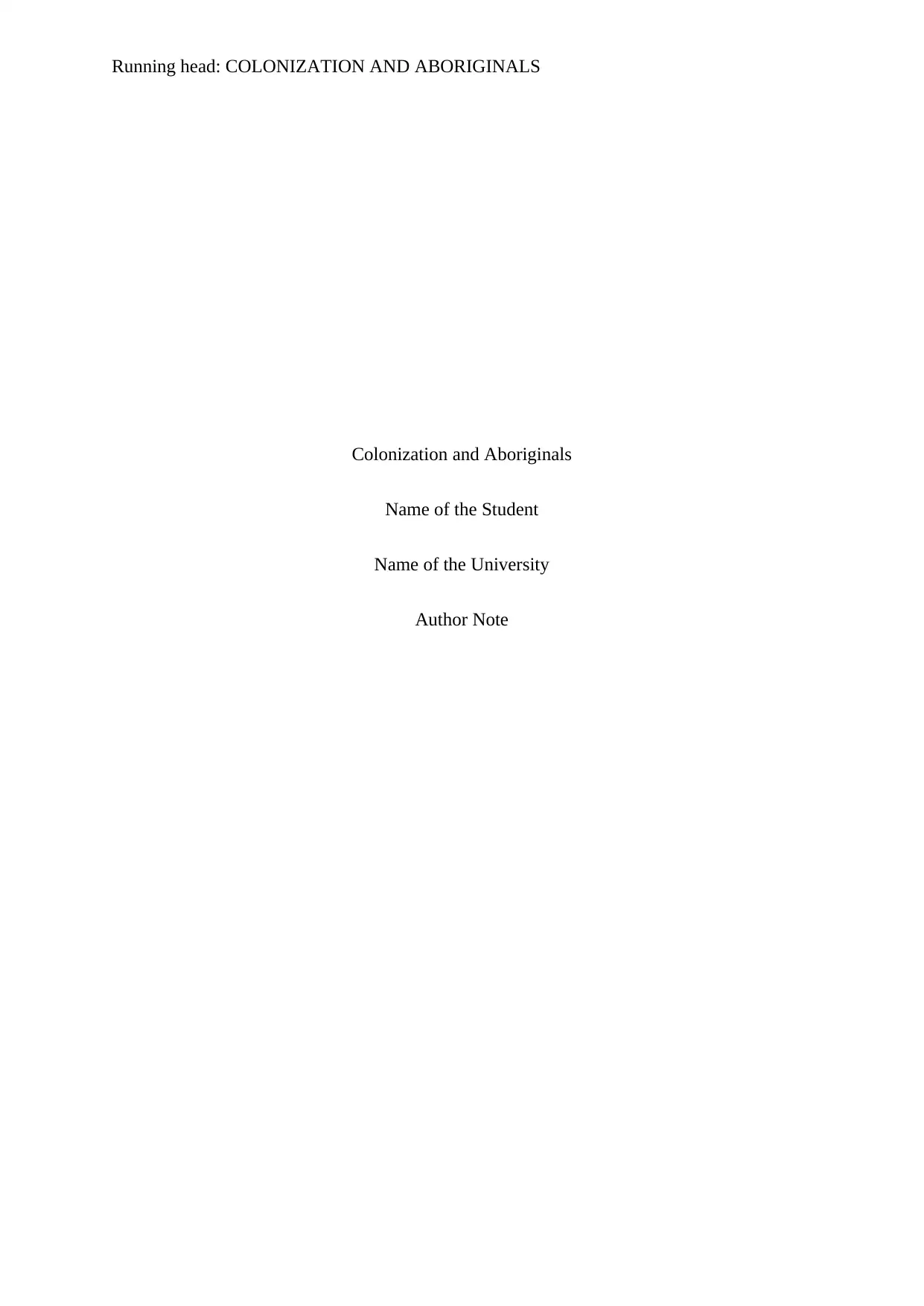
Running head: COLONIZATION AND ABORIGINALS
Colonization and Aboriginals
Name of the Student
Name of the University
Author Note
Colonization and Aboriginals
Name of the Student
Name of the University
Author Note
Paraphrase This Document
Need a fresh take? Get an instant paraphrase of this document with our AI Paraphraser
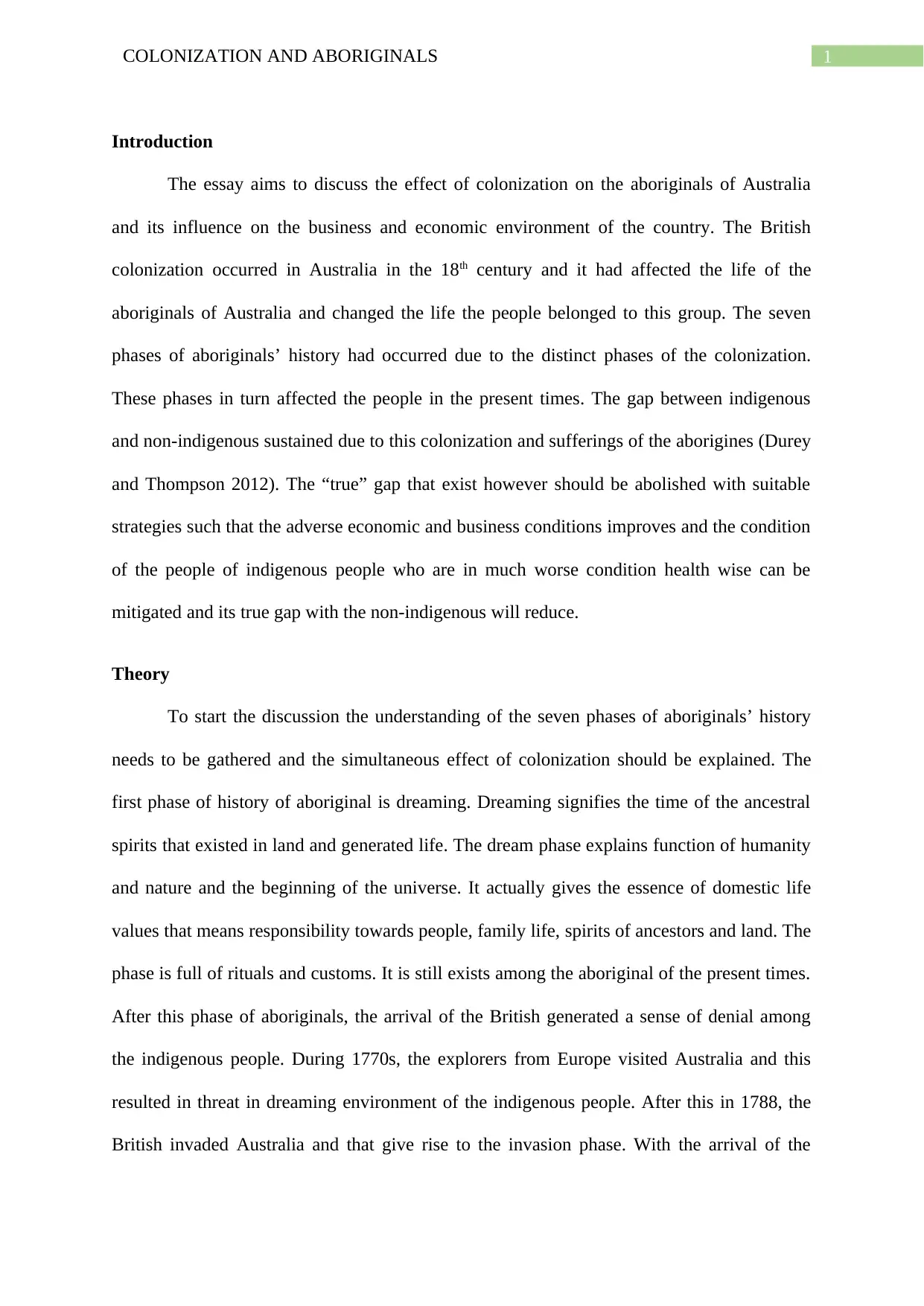
1COLONIZATION AND ABORIGINALS
Introduction
The essay aims to discuss the effect of colonization on the aboriginals of Australia
and its influence on the business and economic environment of the country. The British
colonization occurred in Australia in the 18th century and it had affected the life of the
aboriginals of Australia and changed the life the people belonged to this group. The seven
phases of aboriginals’ history had occurred due to the distinct phases of the colonization.
These phases in turn affected the people in the present times. The gap between indigenous
and non-indigenous sustained due to this colonization and sufferings of the aborigines (Durey
and Thompson 2012). The “true” gap that exist however should be abolished with suitable
strategies such that the adverse economic and business conditions improves and the condition
of the people of indigenous people who are in much worse condition health wise can be
mitigated and its true gap with the non-indigenous will reduce.
Theory
To start the discussion the understanding of the seven phases of aboriginals’ history
needs to be gathered and the simultaneous effect of colonization should be explained. The
first phase of history of aboriginal is dreaming. Dreaming signifies the time of the ancestral
spirits that existed in land and generated life. The dream phase explains function of humanity
and nature and the beginning of the universe. It actually gives the essence of domestic life
values that means responsibility towards people, family life, spirits of ancestors and land. The
phase is full of rituals and customs. It is still exists among the aboriginal of the present times.
After this phase of aboriginals, the arrival of the British generated a sense of denial among
the indigenous people. During 1770s, the explorers from Europe visited Australia and this
resulted in threat in dreaming environment of the indigenous people. After this in 1788, the
British invaded Australia and that give rise to the invasion phase. With the arrival of the
Introduction
The essay aims to discuss the effect of colonization on the aboriginals of Australia
and its influence on the business and economic environment of the country. The British
colonization occurred in Australia in the 18th century and it had affected the life of the
aboriginals of Australia and changed the life the people belonged to this group. The seven
phases of aboriginals’ history had occurred due to the distinct phases of the colonization.
These phases in turn affected the people in the present times. The gap between indigenous
and non-indigenous sustained due to this colonization and sufferings of the aborigines (Durey
and Thompson 2012). The “true” gap that exist however should be abolished with suitable
strategies such that the adverse economic and business conditions improves and the condition
of the people of indigenous people who are in much worse condition health wise can be
mitigated and its true gap with the non-indigenous will reduce.
Theory
To start the discussion the understanding of the seven phases of aboriginals’ history
needs to be gathered and the simultaneous effect of colonization should be explained. The
first phase of history of aboriginal is dreaming. Dreaming signifies the time of the ancestral
spirits that existed in land and generated life. The dream phase explains function of humanity
and nature and the beginning of the universe. It actually gives the essence of domestic life
values that means responsibility towards people, family life, spirits of ancestors and land. The
phase is full of rituals and customs. It is still exists among the aboriginal of the present times.
After this phase of aboriginals, the arrival of the British generated a sense of denial among
the indigenous people. During 1770s, the explorers from Europe visited Australia and this
resulted in threat in dreaming environment of the indigenous people. After this in 1788, the
British invaded Australia and that give rise to the invasion phase. With the arrival of the
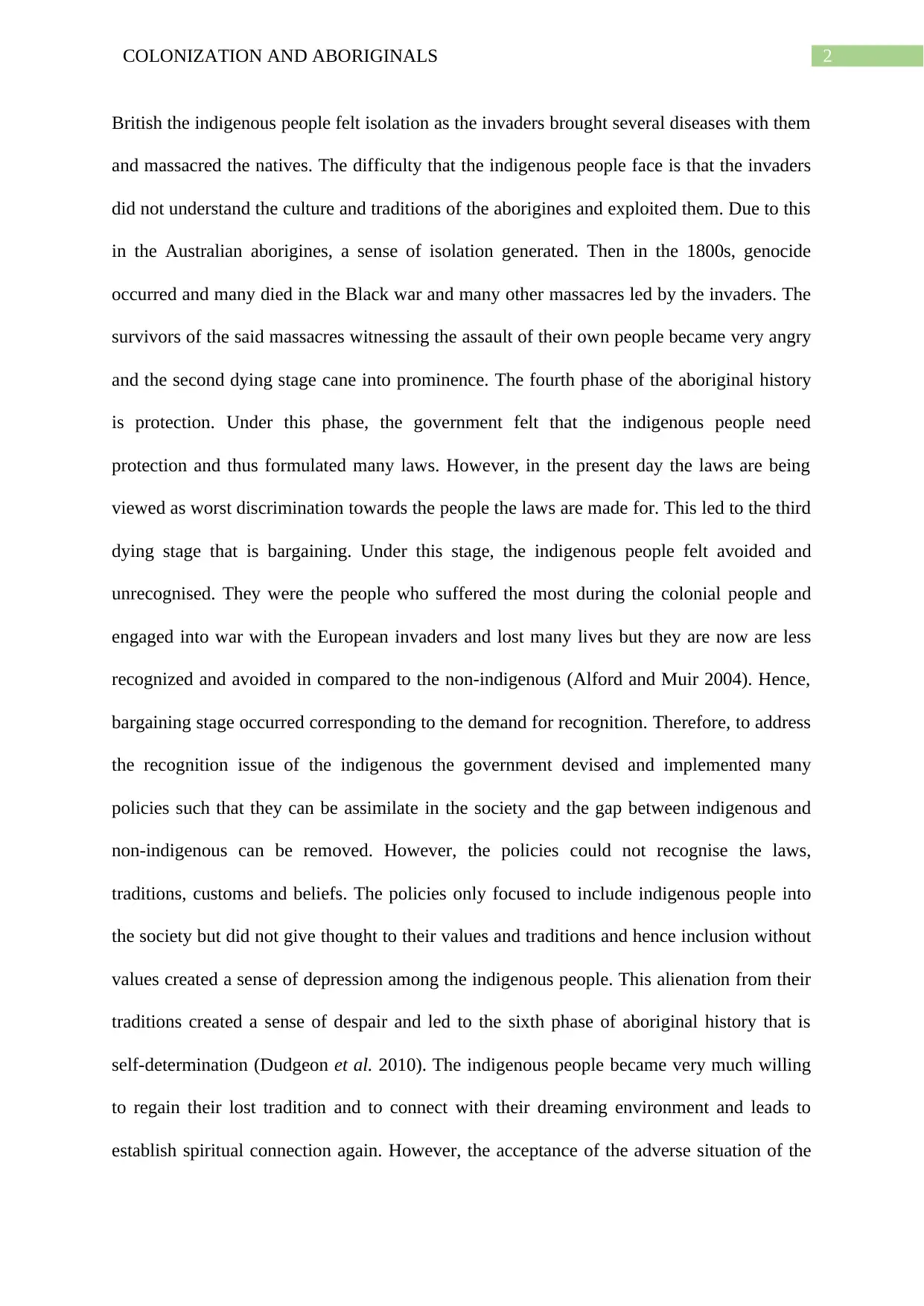
2COLONIZATION AND ABORIGINALS
British the indigenous people felt isolation as the invaders brought several diseases with them
and massacred the natives. The difficulty that the indigenous people face is that the invaders
did not understand the culture and traditions of the aborigines and exploited them. Due to this
in the Australian aborigines, a sense of isolation generated. Then in the 1800s, genocide
occurred and many died in the Black war and many other massacres led by the invaders. The
survivors of the said massacres witnessing the assault of their own people became very angry
and the second dying stage cane into prominence. The fourth phase of the aboriginal history
is protection. Under this phase, the government felt that the indigenous people need
protection and thus formulated many laws. However, in the present day the laws are being
viewed as worst discrimination towards the people the laws are made for. This led to the third
dying stage that is bargaining. Under this stage, the indigenous people felt avoided and
unrecognised. They were the people who suffered the most during the colonial people and
engaged into war with the European invaders and lost many lives but they are now are less
recognized and avoided in compared to the non-indigenous (Alford and Muir 2004). Hence,
bargaining stage occurred corresponding to the demand for recognition. Therefore, to address
the recognition issue of the indigenous the government devised and implemented many
policies such that they can be assimilate in the society and the gap between indigenous and
non-indigenous can be removed. However, the policies could not recognise the laws,
traditions, customs and beliefs. The policies only focused to include indigenous people into
the society but did not give thought to their values and traditions and hence inclusion without
values created a sense of depression among the indigenous people. This alienation from their
traditions created a sense of despair and led to the sixth phase of aboriginal history that is
self-determination (Dudgeon et al. 2010). The indigenous people became very much willing
to regain their lost tradition and to connect with their dreaming environment and leads to
establish spiritual connection again. However, the acceptance of the adverse situation of the
British the indigenous people felt isolation as the invaders brought several diseases with them
and massacred the natives. The difficulty that the indigenous people face is that the invaders
did not understand the culture and traditions of the aborigines and exploited them. Due to this
in the Australian aborigines, a sense of isolation generated. Then in the 1800s, genocide
occurred and many died in the Black war and many other massacres led by the invaders. The
survivors of the said massacres witnessing the assault of their own people became very angry
and the second dying stage cane into prominence. The fourth phase of the aboriginal history
is protection. Under this phase, the government felt that the indigenous people need
protection and thus formulated many laws. However, in the present day the laws are being
viewed as worst discrimination towards the people the laws are made for. This led to the third
dying stage that is bargaining. Under this stage, the indigenous people felt avoided and
unrecognised. They were the people who suffered the most during the colonial people and
engaged into war with the European invaders and lost many lives but they are now are less
recognized and avoided in compared to the non-indigenous (Alford and Muir 2004). Hence,
bargaining stage occurred corresponding to the demand for recognition. Therefore, to address
the recognition issue of the indigenous the government devised and implemented many
policies such that they can be assimilate in the society and the gap between indigenous and
non-indigenous can be removed. However, the policies could not recognise the laws,
traditions, customs and beliefs. The policies only focused to include indigenous people into
the society but did not give thought to their values and traditions and hence inclusion without
values created a sense of depression among the indigenous people. This alienation from their
traditions created a sense of despair and led to the sixth phase of aboriginal history that is
self-determination (Dudgeon et al. 2010). The indigenous people became very much willing
to regain their lost tradition and to connect with their dreaming environment and leads to
establish spiritual connection again. However, the acceptance of the adverse situation of the
⊘ This is a preview!⊘
Do you want full access?
Subscribe today to unlock all pages.

Trusted by 1+ million students worldwide
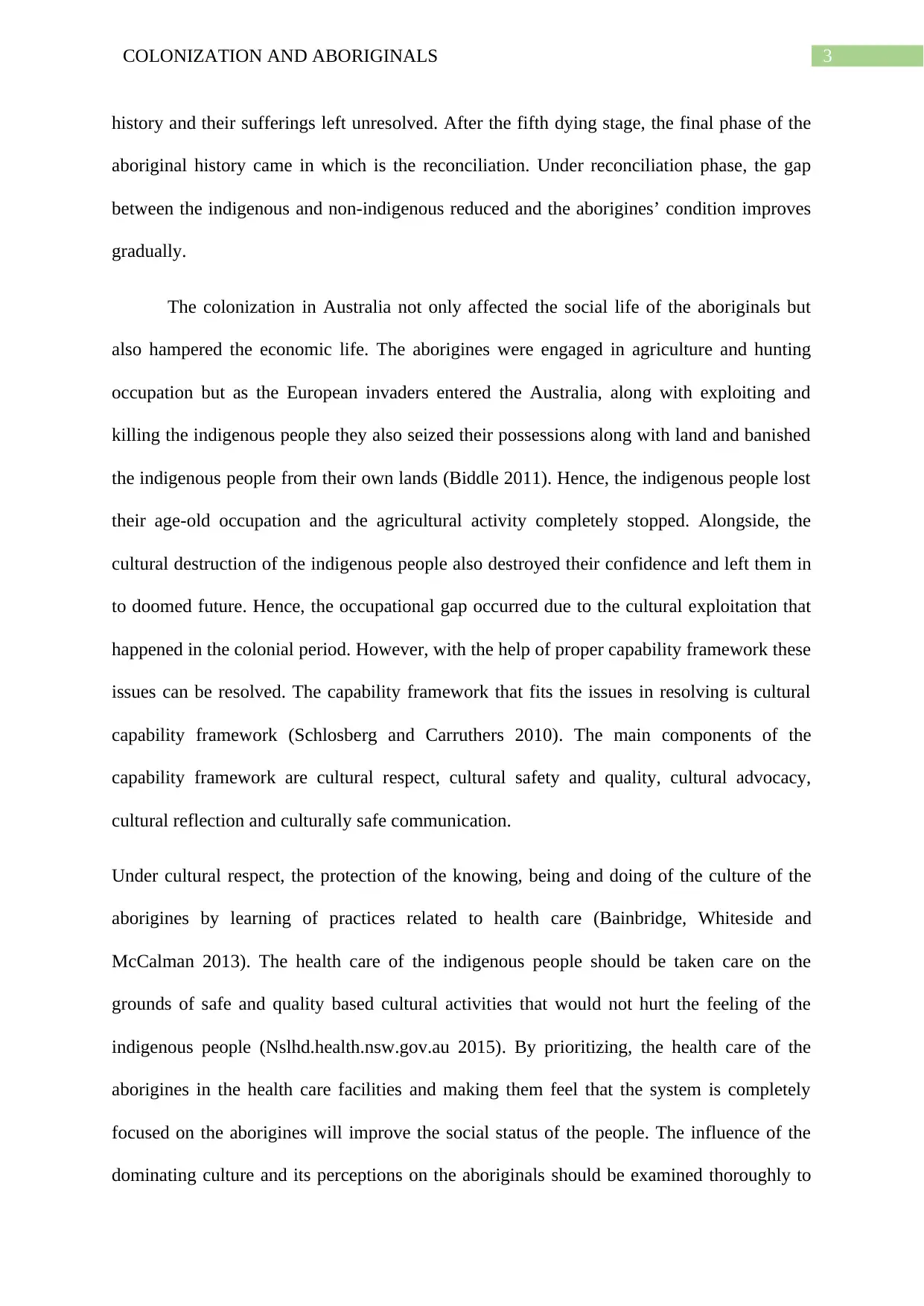
3COLONIZATION AND ABORIGINALS
history and their sufferings left unresolved. After the fifth dying stage, the final phase of the
aboriginal history came in which is the reconciliation. Under reconciliation phase, the gap
between the indigenous and non-indigenous reduced and the aborigines’ condition improves
gradually.
The colonization in Australia not only affected the social life of the aboriginals but
also hampered the economic life. The aborigines were engaged in agriculture and hunting
occupation but as the European invaders entered the Australia, along with exploiting and
killing the indigenous people they also seized their possessions along with land and banished
the indigenous people from their own lands (Biddle 2011). Hence, the indigenous people lost
their age-old occupation and the agricultural activity completely stopped. Alongside, the
cultural destruction of the indigenous people also destroyed their confidence and left them in
to doomed future. Hence, the occupational gap occurred due to the cultural exploitation that
happened in the colonial period. However, with the help of proper capability framework these
issues can be resolved. The capability framework that fits the issues in resolving is cultural
capability framework (Schlosberg and Carruthers 2010). The main components of the
capability framework are cultural respect, cultural safety and quality, cultural advocacy,
cultural reflection and culturally safe communication.
Under cultural respect, the protection of the knowing, being and doing of the culture of the
aborigines by learning of practices related to health care (Bainbridge, Whiteside and
McCalman 2013). The health care of the indigenous people should be taken care on the
grounds of safe and quality based cultural activities that would not hurt the feeling of the
indigenous people (Nslhd.health.nsw.gov.au 2015). By prioritizing, the health care of the
aborigines in the health care facilities and making them feel that the system is completely
focused on the aborigines will improve the social status of the people. The influence of the
dominating culture and its perceptions on the aboriginals should be examined thoroughly to
history and their sufferings left unresolved. After the fifth dying stage, the final phase of the
aboriginal history came in which is the reconciliation. Under reconciliation phase, the gap
between the indigenous and non-indigenous reduced and the aborigines’ condition improves
gradually.
The colonization in Australia not only affected the social life of the aboriginals but
also hampered the economic life. The aborigines were engaged in agriculture and hunting
occupation but as the European invaders entered the Australia, along with exploiting and
killing the indigenous people they also seized their possessions along with land and banished
the indigenous people from their own lands (Biddle 2011). Hence, the indigenous people lost
their age-old occupation and the agricultural activity completely stopped. Alongside, the
cultural destruction of the indigenous people also destroyed their confidence and left them in
to doomed future. Hence, the occupational gap occurred due to the cultural exploitation that
happened in the colonial period. However, with the help of proper capability framework these
issues can be resolved. The capability framework that fits the issues in resolving is cultural
capability framework (Schlosberg and Carruthers 2010). The main components of the
capability framework are cultural respect, cultural safety and quality, cultural advocacy,
cultural reflection and culturally safe communication.
Under cultural respect, the protection of the knowing, being and doing of the culture of the
aborigines by learning of practices related to health care (Bainbridge, Whiteside and
McCalman 2013). The health care of the indigenous people should be taken care on the
grounds of safe and quality based cultural activities that would not hurt the feeling of the
indigenous people (Nslhd.health.nsw.gov.au 2015). By prioritizing, the health care of the
aborigines in the health care facilities and making them feel that the system is completely
focused on the aborigines will improve the social status of the people. The influence of the
dominating culture and its perceptions on the aboriginals should be examined thoroughly to
Paraphrase This Document
Need a fresh take? Get an instant paraphrase of this document with our AI Paraphraser
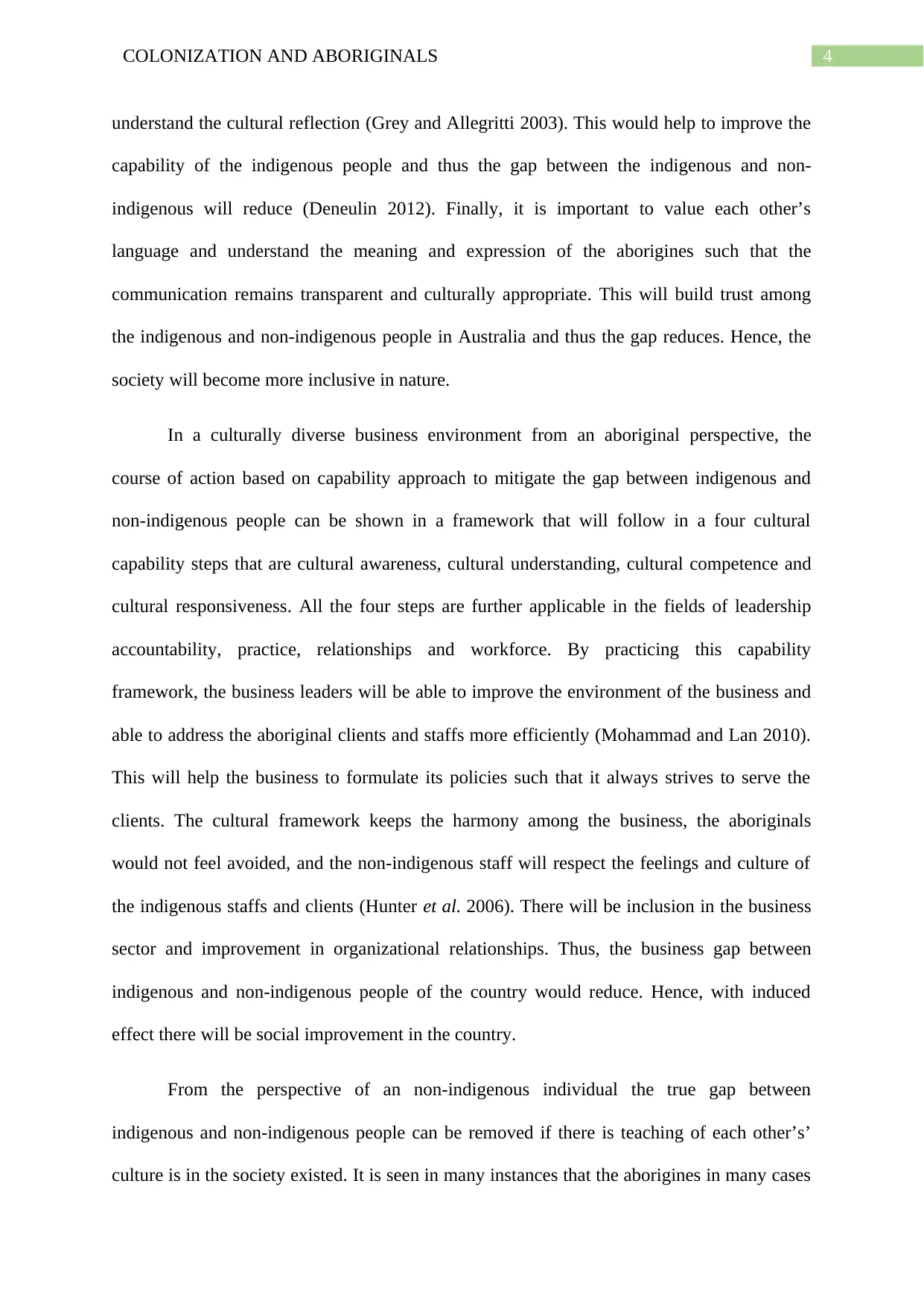
4COLONIZATION AND ABORIGINALS
understand the cultural reflection (Grey and Allegritti 2003). This would help to improve the
capability of the indigenous people and thus the gap between the indigenous and non-
indigenous will reduce (Deneulin 2012). Finally, it is important to value each other’s
language and understand the meaning and expression of the aborigines such that the
communication remains transparent and culturally appropriate. This will build trust among
the indigenous and non-indigenous people in Australia and thus the gap reduces. Hence, the
society will become more inclusive in nature.
In a culturally diverse business environment from an aboriginal perspective, the
course of action based on capability approach to mitigate the gap between indigenous and
non-indigenous people can be shown in a framework that will follow in a four cultural
capability steps that are cultural awareness, cultural understanding, cultural competence and
cultural responsiveness. All the four steps are further applicable in the fields of leadership
accountability, practice, relationships and workforce. By practicing this capability
framework, the business leaders will be able to improve the environment of the business and
able to address the aboriginal clients and staffs more efficiently (Mohammad and Lan 2010).
This will help the business to formulate its policies such that it always strives to serve the
clients. The cultural framework keeps the harmony among the business, the aboriginals
would not feel avoided, and the non-indigenous staff will respect the feelings and culture of
the indigenous staffs and clients (Hunter et al. 2006). There will be inclusion in the business
sector and improvement in organizational relationships. Thus, the business gap between
indigenous and non-indigenous people of the country would reduce. Hence, with induced
effect there will be social improvement in the country.
From the perspective of an non-indigenous individual the true gap between
indigenous and non-indigenous people can be removed if there is teaching of each other’s’
culture is in the society existed. It is seen in many instances that the aborigines in many cases
understand the cultural reflection (Grey and Allegritti 2003). This would help to improve the
capability of the indigenous people and thus the gap between the indigenous and non-
indigenous will reduce (Deneulin 2012). Finally, it is important to value each other’s
language and understand the meaning and expression of the aborigines such that the
communication remains transparent and culturally appropriate. This will build trust among
the indigenous and non-indigenous people in Australia and thus the gap reduces. Hence, the
society will become more inclusive in nature.
In a culturally diverse business environment from an aboriginal perspective, the
course of action based on capability approach to mitigate the gap between indigenous and
non-indigenous people can be shown in a framework that will follow in a four cultural
capability steps that are cultural awareness, cultural understanding, cultural competence and
cultural responsiveness. All the four steps are further applicable in the fields of leadership
accountability, practice, relationships and workforce. By practicing this capability
framework, the business leaders will be able to improve the environment of the business and
able to address the aboriginal clients and staffs more efficiently (Mohammad and Lan 2010).
This will help the business to formulate its policies such that it always strives to serve the
clients. The cultural framework keeps the harmony among the business, the aboriginals
would not feel avoided, and the non-indigenous staff will respect the feelings and culture of
the indigenous staffs and clients (Hunter et al. 2006). There will be inclusion in the business
sector and improvement in organizational relationships. Thus, the business gap between
indigenous and non-indigenous people of the country would reduce. Hence, with induced
effect there will be social improvement in the country.
From the perspective of an non-indigenous individual the true gap between
indigenous and non-indigenous people can be removed if there is teaching of each other’s’
culture is in the society existed. It is seen in many instances that the aborigines in many cases
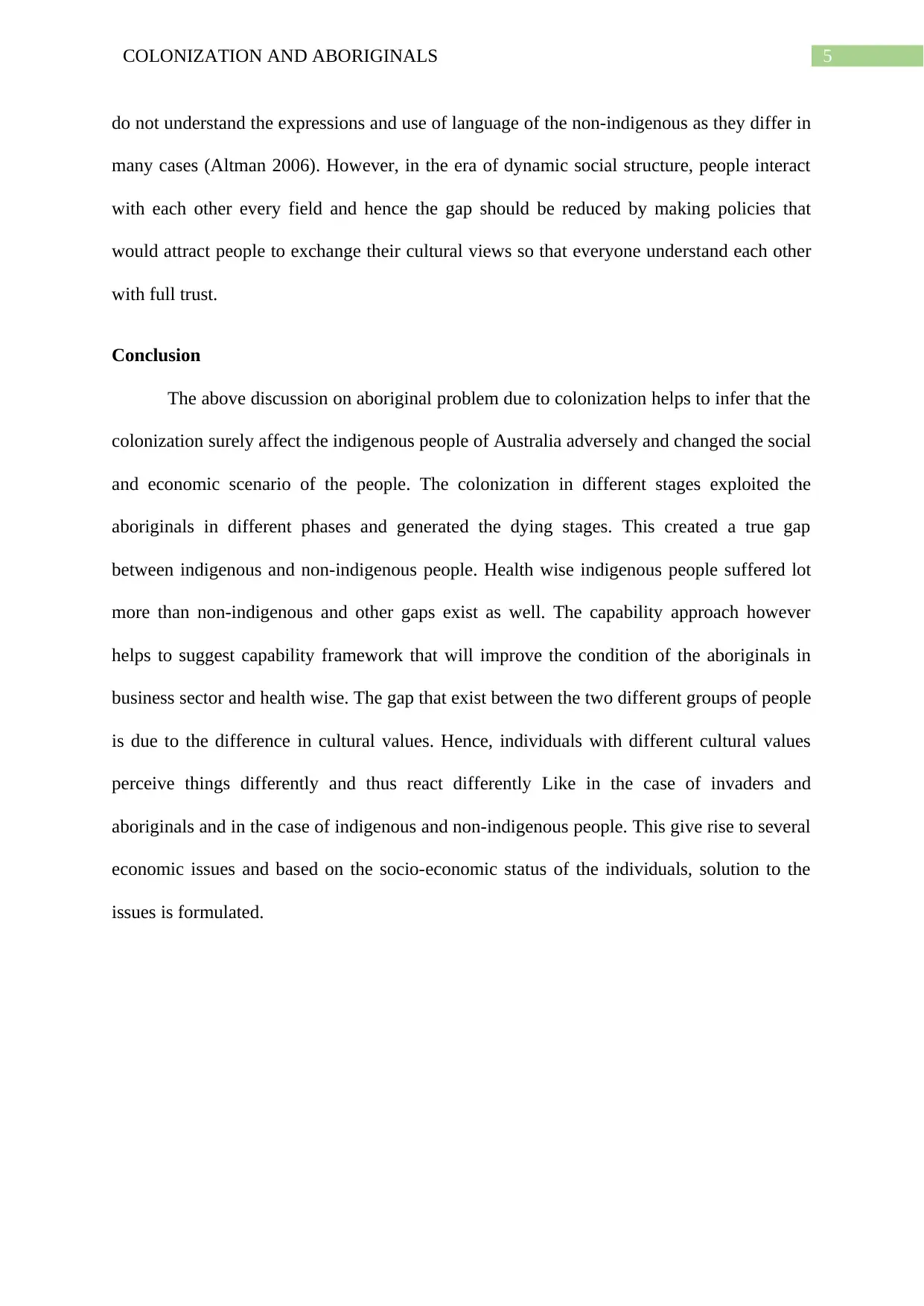
5COLONIZATION AND ABORIGINALS
do not understand the expressions and use of language of the non-indigenous as they differ in
many cases (Altman 2006). However, in the era of dynamic social structure, people interact
with each other every field and hence the gap should be reduced by making policies that
would attract people to exchange their cultural views so that everyone understand each other
with full trust.
Conclusion
The above discussion on aboriginal problem due to colonization helps to infer that the
colonization surely affect the indigenous people of Australia adversely and changed the social
and economic scenario of the people. The colonization in different stages exploited the
aboriginals in different phases and generated the dying stages. This created a true gap
between indigenous and non-indigenous people. Health wise indigenous people suffered lot
more than non-indigenous and other gaps exist as well. The capability approach however
helps to suggest capability framework that will improve the condition of the aboriginals in
business sector and health wise. The gap that exist between the two different groups of people
is due to the difference in cultural values. Hence, individuals with different cultural values
perceive things differently and thus react differently Like in the case of invaders and
aboriginals and in the case of indigenous and non-indigenous people. This give rise to several
economic issues and based on the socio-economic status of the individuals, solution to the
issues is formulated.
do not understand the expressions and use of language of the non-indigenous as they differ in
many cases (Altman 2006). However, in the era of dynamic social structure, people interact
with each other every field and hence the gap should be reduced by making policies that
would attract people to exchange their cultural views so that everyone understand each other
with full trust.
Conclusion
The above discussion on aboriginal problem due to colonization helps to infer that the
colonization surely affect the indigenous people of Australia adversely and changed the social
and economic scenario of the people. The colonization in different stages exploited the
aboriginals in different phases and generated the dying stages. This created a true gap
between indigenous and non-indigenous people. Health wise indigenous people suffered lot
more than non-indigenous and other gaps exist as well. The capability approach however
helps to suggest capability framework that will improve the condition of the aboriginals in
business sector and health wise. The gap that exist between the two different groups of people
is due to the difference in cultural values. Hence, individuals with different cultural values
perceive things differently and thus react differently Like in the case of invaders and
aboriginals and in the case of indigenous and non-indigenous people. This give rise to several
economic issues and based on the socio-economic status of the individuals, solution to the
issues is formulated.
⊘ This is a preview!⊘
Do you want full access?
Subscribe today to unlock all pages.

Trusted by 1+ million students worldwide
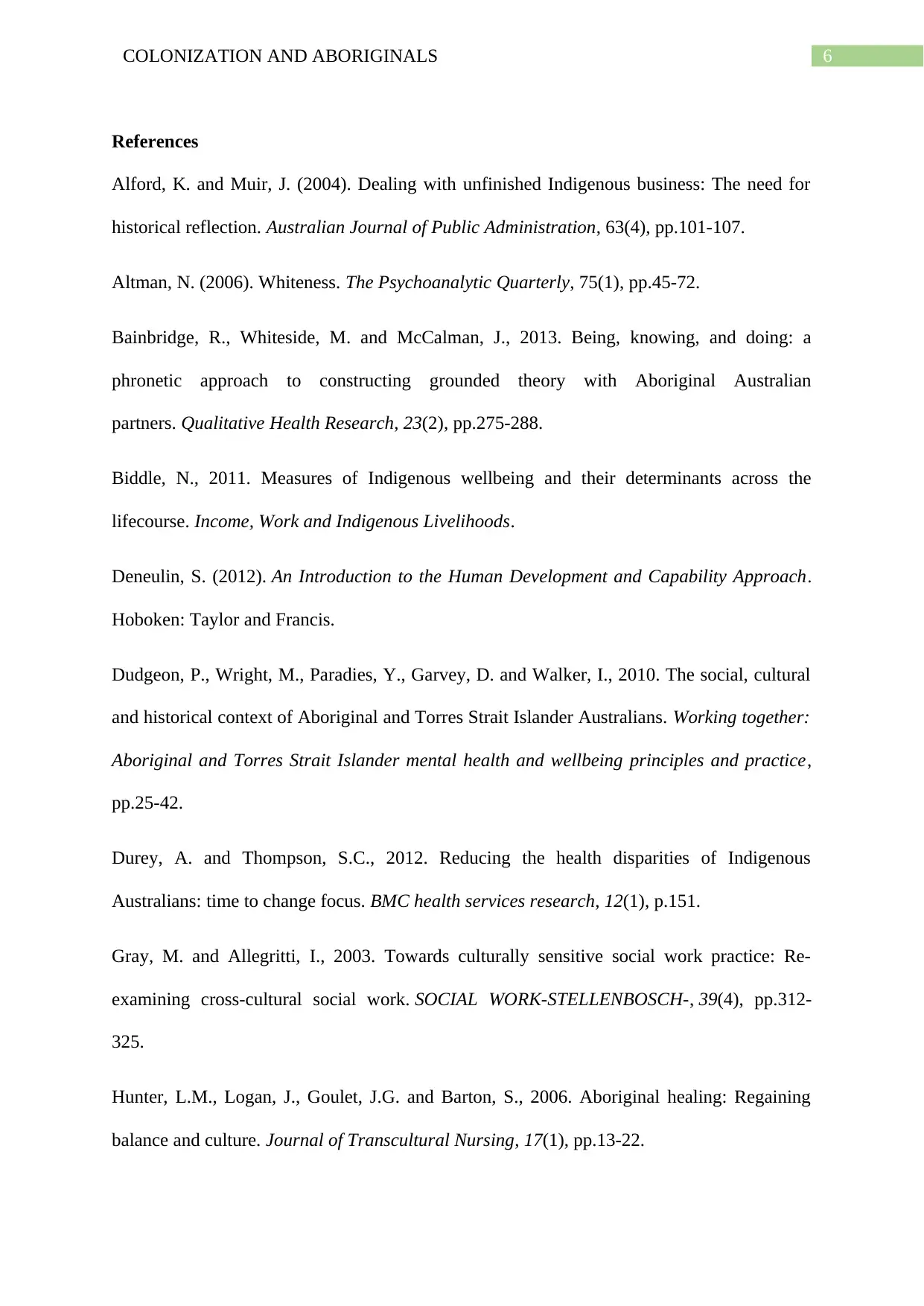
6COLONIZATION AND ABORIGINALS
References
Alford, K. and Muir, J. (2004). Dealing with unfinished Indigenous business: The need for
historical reflection. Australian Journal of Public Administration, 63(4), pp.101-107.
Altman, N. (2006). Whiteness. The Psychoanalytic Quarterly, 75(1), pp.45-72.
Bainbridge, R., Whiteside, M. and McCalman, J., 2013. Being, knowing, and doing: a
phronetic approach to constructing grounded theory with Aboriginal Australian
partners. Qualitative Health Research, 23(2), pp.275-288.
Biddle, N., 2011. Measures of Indigenous wellbeing and their determinants across the
lifecourse. Income, Work and Indigenous Livelihoods.
Deneulin, S. (2012). An Introduction to the Human Development and Capability Approach.
Hoboken: Taylor and Francis.
Dudgeon, P., Wright, M., Paradies, Y., Garvey, D. and Walker, I., 2010. The social, cultural
and historical context of Aboriginal and Torres Strait Islander Australians. Working together:
Aboriginal and Torres Strait Islander mental health and wellbeing principles and practice,
pp.25-42.
Durey, A. and Thompson, S.C., 2012. Reducing the health disparities of Indigenous
Australians: time to change focus. BMC health services research, 12(1), p.151.
Gray, M. and Allegritti, I., 2003. Towards culturally sensitive social work practice: Re-
examining cross-cultural social work. SOCIAL WORK-STELLENBOSCH-, 39(4), pp.312-
325.
Hunter, L.M., Logan, J., Goulet, J.G. and Barton, S., 2006. Aboriginal healing: Regaining
balance and culture. Journal of Transcultural Nursing, 17(1), pp.13-22.
References
Alford, K. and Muir, J. (2004). Dealing with unfinished Indigenous business: The need for
historical reflection. Australian Journal of Public Administration, 63(4), pp.101-107.
Altman, N. (2006). Whiteness. The Psychoanalytic Quarterly, 75(1), pp.45-72.
Bainbridge, R., Whiteside, M. and McCalman, J., 2013. Being, knowing, and doing: a
phronetic approach to constructing grounded theory with Aboriginal Australian
partners. Qualitative Health Research, 23(2), pp.275-288.
Biddle, N., 2011. Measures of Indigenous wellbeing and their determinants across the
lifecourse. Income, Work and Indigenous Livelihoods.
Deneulin, S. (2012). An Introduction to the Human Development and Capability Approach.
Hoboken: Taylor and Francis.
Dudgeon, P., Wright, M., Paradies, Y., Garvey, D. and Walker, I., 2010. The social, cultural
and historical context of Aboriginal and Torres Strait Islander Australians. Working together:
Aboriginal and Torres Strait Islander mental health and wellbeing principles and practice,
pp.25-42.
Durey, A. and Thompson, S.C., 2012. Reducing the health disparities of Indigenous
Australians: time to change focus. BMC health services research, 12(1), p.151.
Gray, M. and Allegritti, I., 2003. Towards culturally sensitive social work practice: Re-
examining cross-cultural social work. SOCIAL WORK-STELLENBOSCH-, 39(4), pp.312-
325.
Hunter, L.M., Logan, J., Goulet, J.G. and Barton, S., 2006. Aboriginal healing: Regaining
balance and culture. Journal of Transcultural Nursing, 17(1), pp.13-22.
Paraphrase This Document
Need a fresh take? Get an instant paraphrase of this document with our AI Paraphraser
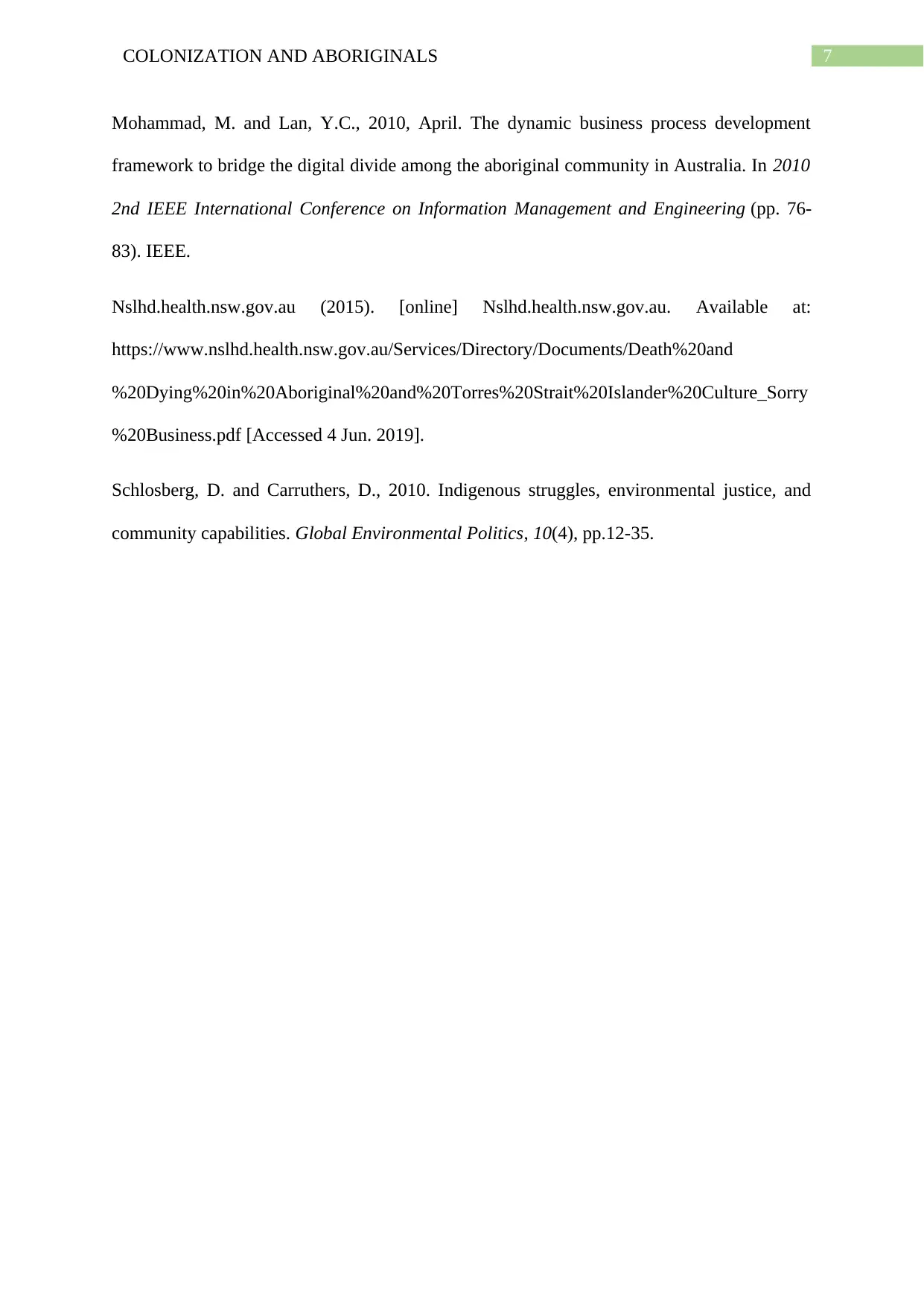
7COLONIZATION AND ABORIGINALS
Mohammad, M. and Lan, Y.C., 2010, April. The dynamic business process development
framework to bridge the digital divide among the aboriginal community in Australia. In 2010
2nd IEEE International Conference on Information Management and Engineering (pp. 76-
83). IEEE.
Nslhd.health.nsw.gov.au (2015). [online] Nslhd.health.nsw.gov.au. Available at:
https://www.nslhd.health.nsw.gov.au/Services/Directory/Documents/Death%20and
%20Dying%20in%20Aboriginal%20and%20Torres%20Strait%20Islander%20Culture_Sorry
%20Business.pdf [Accessed 4 Jun. 2019].
Schlosberg, D. and Carruthers, D., 2010. Indigenous struggles, environmental justice, and
community capabilities. Global Environmental Politics, 10(4), pp.12-35.
Mohammad, M. and Lan, Y.C., 2010, April. The dynamic business process development
framework to bridge the digital divide among the aboriginal community in Australia. In 2010
2nd IEEE International Conference on Information Management and Engineering (pp. 76-
83). IEEE.
Nslhd.health.nsw.gov.au (2015). [online] Nslhd.health.nsw.gov.au. Available at:
https://www.nslhd.health.nsw.gov.au/Services/Directory/Documents/Death%20and
%20Dying%20in%20Aboriginal%20and%20Torres%20Strait%20Islander%20Culture_Sorry
%20Business.pdf [Accessed 4 Jun. 2019].
Schlosberg, D. and Carruthers, D., 2010. Indigenous struggles, environmental justice, and
community capabilities. Global Environmental Politics, 10(4), pp.12-35.
1 out of 8
Related Documents
Your All-in-One AI-Powered Toolkit for Academic Success.
+13062052269
info@desklib.com
Available 24*7 on WhatsApp / Email
![[object Object]](/_next/static/media/star-bottom.7253800d.svg)
Unlock your academic potential
Copyright © 2020–2025 A2Z Services. All Rights Reserved. Developed and managed by ZUCOL.





